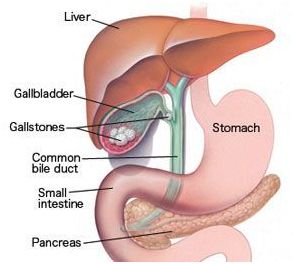Gallbladder Surgery (Cholecystectomy)
 The gallbladder is a small, muscular bag that lives beneath your liver in the right upper quadrant of your abdominal cavity. Your liver produces bile, a fluid that helps digest fats in the small intestine. Your gallbladder stores bile throughout the day and releases it into the main bile duct. It then drains into the small intestine. Your gallbladder will sometimes develop gallstones when your body improperly processes cholesterol. Stones will then precipitate inside the gallbladder. Other times, the gallbladder will simply become dysfunctional and produce the same symptoms as gallstones. This condition is called biliary dyskinesia.
The gallbladder is a small, muscular bag that lives beneath your liver in the right upper quadrant of your abdominal cavity. Your liver produces bile, a fluid that helps digest fats in the small intestine. Your gallbladder stores bile throughout the day and releases it into the main bile duct. It then drains into the small intestine. Your gallbladder will sometimes develop gallstones when your body improperly processes cholesterol. Stones will then precipitate inside the gallbladder. Other times, the gallbladder will simply become dysfunctional and produce the same symptoms as gallstones. This condition is called biliary dyskinesia.
Gallbladder Disease Symptoms
- Indigestion
- Nausea
- Vomiting
- Diarrhea
- Back and/or shoulder pain
- Infection
- Pain in the middle or right upper side of your belly after eating
Gallbladder Attack
A severe onset of these symptoms is sometimes referred to as a “gallbladder attack”. In some cases, if you are seen through the emergency room, you may be taken into surgery the same or next day. This is not always the case. If seen in your primary physician’s office for some or all of these symptoms, your doctor may order an Ultrasound, CT or CAT scan, hepatobiliary (HIDA) scan, or another test to identify or confirm gallstones.
The best option is usually surgical removal of the gallbladder. Medical management is a possibility in special cases. This is often poorly tolerated and the results are usually temporary.
Gallstones
Gallstones can be quite painful and, if left untreated, can lead to serious complications. If the stones move to nearby bile ducts, they can cause blockages or inflammation of the pancreas. Jaundice (buildup of bile chemicals in the blood) can also occur. Symptoms of jaundice include a yellowing of the eyes and skin, dark urine, and itching.
Gallbladder Surgery
Cholecystectomy
Gallbladder surgery (cholecystectomy) is most often performed laparoscopically. Laparoscopic surgery offers a minimally invasive approach to gallbladder removal and allows for faster healing time. A traditional open surgery may be required in rare circumstances.
Once you are taken to the operating room and are asleep using general anesthesia, a small incision around your naval will be created where a tiny lighted video camera, called a laparoscope, is inserted. During your consultation, we will discuss the various treatment options and most appropriate method for managing your symptoms. This may include Single Incisions Laparoscopic Removal (SILS) or traditional 4-port laparoscopy. Through various small incision(s) and dissecting instruments, your gallbladder is removed from beneath the liver bed and retrieved through your navel in a sterile plastic bag. To make it easier to visualize your gallbladder, your abdominal cavity is inflated with Carbon Dioxide gas. The incision(s) are closed with dissolvable sutures and covered with steri-strips. Rarely, open (traditional) surgery may be required.
In special circumstances, a dye is injected into your bile duct and an X-ray (cholangiogram) is used to determine if gallstones have migrated out of the gallbladder. These may need to be removed after surgery with an additional procedure called an ERCP (endoscopic retrograde pancreatography). This is coordinated with a Gastroenterologist.
After the procedure is complete, you will be taken to the recovery room for a few hours to wake up from the anesthesia and have something to eat. You will also be asked to get up and walk a little to aid in the recovery process. If you have had Laparoscopic surgery, you will likely return home the same day. If you had open surgery you may remain in the hospital for a few days.
Some patients are candidates for SILS or Single Incision Laparoscopic Surgery.
Getting Back to Normal
- You may advance your diet as tolerated. Most patients can eventually resume a normal diet without restrictions. Post-operatively you may experience some food intolerances. This presents with heartburn, nausea, indigestion or diarrhea. During your recovery, you may wish to avoid meals that cause these symptoms (i.e. spicy, greasy, rich, or heavy foods). This is often temporary. It can uncommonly be a permanent lifestyle modification.
- Following your surgery, you may experience constipation while taking the pain medications. This is normal and should resolve itself. To aid in this process, use over the counter stool softeners and fiber supplement.
- Right shoulder pain is especially common for the first 24-36 hours. It generally passes quickly. A protected heating pad is sometimes helpful.
- You will be allowed to shower the day after your surgery. Avoid soaking in a bath or hot tub until after your follow-up visit.
- You will be restricted from lifting anything over 30 pounds for 2 weeks after surgery to allow healing.
- Ease back into your normal daily activity and be sure to eat balanced healthy meals.
- Please be sure to schedule a post-op appointment 7-14 days after your surgery, so the doctor can evaluate your recovery progress.
